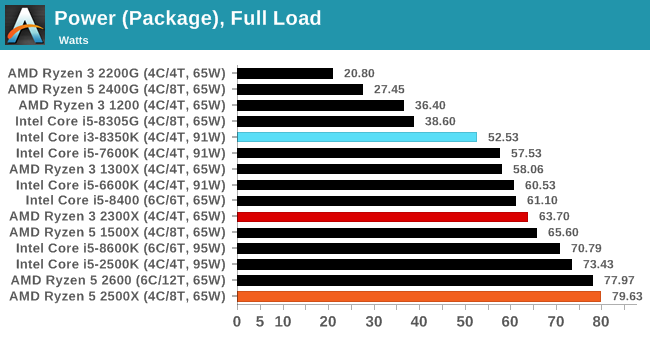The AMD Ryzen 5 2500X and Ryzen 3 2300X CPU Review
by Ian Cutress on February 11, 2019 11:45 AM ESTPower Consumption and TDP
The way AMD and Intel use the term Thermal Design Power (TDP) is different. Technically it is a measure of cooling ability needed for a given processor, which is how AMD use it, or the more common way is a measure of power consumption, how Intel does it. The question becomes whether it means sustained power, or turbo power - most people assume it's the latter, but Intel use it for the former (sustained) power. We describe this in detail in our article here:
https://www.anandtech.com/show/13544/why-intel-processors-draw-more-power-than-expected-tdp-turbo
There is also the added factor of the luck of the draw - two processors that have the same name can potentially vary wildly in power consumption. Both AMD and Intel apply 'binning' rules, such that CPUs that hit a minimum grade are stamped as that processor model. This means that a processor can either only just pass the grade, or be a super perfect chip, but still be sold as the same. There is also the possibility that the company could downgrade a higher model and rebadge it to the lower model in order to adjust inventory. This is something to keep in mind when looking at power numbers.
Power Consumption
Power consumption was tested on the system while in a single MSI GTX 1080 GPU configuration with a wall meter connected to a power supply with ~75% efficiency > 50W, and 90%+ efficiency at 250W, suitable for both idle and multi-GPU loading. Our method of power reading actually bypasses the power management of the UEFI and the board to supply components with power under load, instead using the readings that the system is directly be told from the CPU for managing fan speeds, temperatures, current protection, etc. This way of reading the power has positives and negatives, but provides a sustainable CPU-only comparison value.
In our test, we use affinity masking to test from 0 to double the threads of the CPU while running the POV-Ray benchmark, and reporting the peak power from around ~20 seconds into the test when all threads are loaded. The 'Full Load' value takes the peak value out of all the affinity mark sub-tests. POV-Ray uses up to AVX2 instructions, which can draw more power than non-AVX code.

As expected, the 2500X consumes more power than the 2300X, but both are beaten by almost 10W by the Core i3-8350K, and the Core i5-8600K sits in between the two AMD chips. Perhaps suprisingly, our Ryzen 5 2500X sample consumes more power at load than our Ryzen 5 2600 chip, which is rated at the same TDP. It would appear that the 65W TDP of our Ryzen 5 2500X is set too low, or we just have a bad chip that is applying a lot of voltage. The winners in power here are the Ryzen APUs.











65 Comments
View All Comments
Smell This - Tuesday, February 12, 2019 - link
Thanks, Yall!"Where possible, we will extend out testing to include faster memory modules either at the same time as the review or a later date."
____ _____ _____ _____ _______
It would be sweet with some OC action, too.
Most impressive is the jump between the AMD Ryzen 2500X/1500X and Ryzen 3 2300X/1300X --- roughly 10% +/-. Good work, AMD.
I guess this is the difference between Zen and Zen+. With 7nm Zen ++ arriving soon, and Zen+++ next year, the CPU times they are a changin' ...
mr_yogi - Tuesday, February 12, 2019 - link
Love the inclusion of the i5 2500K, great job.Valantar - Tuesday, February 12, 2019 - link
These are both available from Norwegian retailers, though prices are ... not good. The 2500X costs as much as the 2600X, and the 2300X is barely cheaper than the 2600 (though admittedly the 2600 is _really_ cheap).urbanman2004 - Tuesday, February 12, 2019 - link
Reviewing CPU's that'll never reach the mainstream open market. Smart idea Anandtech 😉mikato - Thursday, April 4, 2019 - link
Are you saying it doesn't count if they are sold in prebuilt systems?tygrus - Tuesday, February 12, 2019 - link
AMD APUs (2400G & 2300G) try to keep atleast 50% of the power budget for GPU so the CPU load graph doesn't show the whole picture. It shows the power used for all chips for CPU load not CPU+GPU load. While having a mixture of CPU-only & CPU+GPU chips present means you want to focus on the CPU the reader needs to be reminded that the CPU+GPU load will be higher.I wish AMD had option for 95w TDP APU to compete with Intel models. With more CPU cores/headroom and 25% more GPU to use that 95w+ peak.
azrael- - Wednesday, February 13, 2019 - link
One reason to favor the 2300X and 2500X over the 'G' series CPUs is that Pinnacle Ridge supports ECC whereas Raven Ridge does not.Icehawk - Wednesday, February 13, 2019 - link
I'm begging here - can you please, please, please show us your config settings for the HEVC encoding? You get rates that are 6x+ faster than I can achieve - my O/C'd 8700k gets ~45fps with 1080 Fast 3500 settings using all else as default in Handbrake. I'd really love to hit the #s you get with just an i5. Help!Ian Cutress - Friday, February 15, 2019 - link
Check page 3?https://www.anandtech.com/show/13945/the-amd-ryzen...
xrror - Wednesday, February 13, 2019 - link
One additional savings for OEMs - they won't need to populate the motherboard components for integrated video on systems shipped with these.No need for displayport/HDMI/VGA connectors and associated filtering bits, so that saves a bit more on total BOM for the OEM.